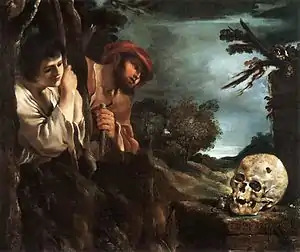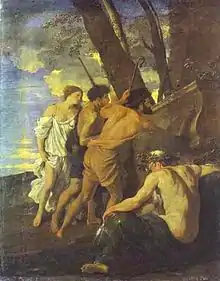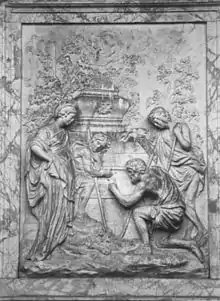Et in Arcadia ego
Et in Arcadia ego (also known as Les bergers d'Arcadie or The Arcadian Shepherds)[1] is a 1637–38 painting by Nicolas Poussin (1594–1665), the leading painter of the classical French Baroque style. It depicts a pastoral scene with idealized shepherds from classical antiquity, and a woman, possibly a shepherdess, gathered around an austere tomb. It is held in the Louvre.
| Et in Arcadia ego | |
|---|---|
| Les Bergers d'Arcadie | |
.jpg.webp) | |
| Artist | Nicolas Poussin |
| Year | 1637–1638 |
| Medium | oil on canvas |
| Dimensions | 85 cm × 121 cm (34.25 in × 47.24 in) |
| Location | Musée du Louvre |
Poussin painted two versions of the subject under the same title. His earlier version, painted in 1627, is held at Chatsworth House. An earlier treatment of the theme was painted by Guercino circa 1618–1622, also titled Et in Arcadia ego.
Inspiration

The first appearance of a tomb with a memorial inscription (to Daphnis) amid the idyllic settings of Arcadia appears in Virgil's Eclogues V 42 ff. Virgil took the idealized Sicilian rustics that had first appeared in the Idylls of Theocritus and set them in the primitive Greek district of Arcadia (see Eclogues VII and X). The idea was taken up anew in the circle of Lorenzo de' Medici in the 1460s and 1470s, during the Florentine Renaissance.
In his pastoral work Arcadia (1504), Jacopo Sannazaro fixed the Early Modern perception of Arcadia as a lost world of idyllic bliss, remembered in regretful dirges. The first pictorial representation of the familiar memento mori theme that was popularized in 16th-century Venice, now made more concrete and vivid by the inscription ET IN ARCADIA EGO, is Guercino's version, painted between 1618 and 1622 (in the Galleria Nazionale d'Arte Antica, Rome), in which the inscription gains force from the prominent presence of a skull in the foreground, beneath which the words are carved.
1627 version

Poussin's own first version of the painting (now in Chatsworth House) was probably commissioned as a reworking of Guercino's version. It is in a far more Baroque style than the later version, characteristic of Poussin's early work. In the Chatsworth painting the shepherds are actively discovering the half-hidden and overgrown tomb, and are reading the inscription with curious expressions. The woman, standing at the left, is posed in sexually suggestive fashion, very different from her austere counterpart in the later version, which is based on a statue from antiquity known as the Cesi Juno.Barker, Emma (1999). "Chapter 2: The History of the Bloggs Family". In Perry, Gill; Cunningham, Colin (eds.). Academies, Museums and Canons of Art. Yale University Press. ISBN 978-0300077438. The later version has a far more geometric composition and the figures are much more contemplative.
Interpretation
The literal translation of "Et in Arcadia Ego" is "Even in Arcadia, there am I". Poussin's earliest biographer, Giovan Pietro Bellori, understood the 'I' of the phrase to refer to Death, thus making the painting a memento mori, reminding the viewer that even in the blissful utopia of Arcadia, death still exists.[2] Another biographer, André Félibien, interpreted the 'I' to refer to the occupant of the tomb, but still took the overall meaning of the painting to be a reminder that death is present even in idyllic Arcadia.[3]
The vagueness of the phrase is the subject of a famous essay by the art historian Erwin Panofsky, who suggested that, compared to Poussin's 1627 version, this second version shifted the focus from a warning about the inevitability of death to a contemplation on the past and a sense of nostalgia.[4]
Sculpted versions

The undated mid-eighteenth-century marble bas-relief is part of the Shepherds Monument, a garden feature at Shugborough House, Staffordshire, England. Beneath it is the cryptic Shugborough inscription, as yet undeciphered.[5] The reversed composition suggests that it was copied from an engraving, the compositions of which are commonly reversed because direct copies to the plate produce mirror images on printing.
In 1832 another relief was sculpted as part of the monument marking Poussin's tomb in Rome, on which it appears beneath a bust of the artist.[6] In the words of the art historian Richard Verdi, it appears as if the shepherds are contemplating "their own author's death."[7]
References in other works
| External video | |
|---|---|
- Et in Arcadia ego (the German Auch ich in Arkadien! is used) is the motto of Italian Journey (1816–17) by Johann Wolfgang von Goethe.[8]
- And I too in Arcadia is a poem by Felicia Hemans, first published in 1824.
| Wikisource has original text related to this article: |
- Et in Arcadia ego is the title of section 295, Volume II, Part Two ("The Wanderer and his Shadow"), of Friedrich Nietzsche's Human, All Too Human (1880). The passage describes a pastoral evening scene in the high mountains, finishing with the lines: "Unconsciously, as if nothing could be more natural, you peopled this pure, clear world of light (which had no trace of yearning, of expectancy, of looking forward or backward) with Greek heroes. You felt it all as Poussin and his school felt it, at once heroic and idyllic. So individual men too have lived, constantly feeling themselves in the world and the world in themselves, and among them one of the greatest men, the inventor of a heroic-idyllic form of philosophy, Epicurus."[9]
- I, Too, Have Lived in Arcadia is the title of the 1942 memoirs of Marie Adelaide Belloc Lowndes, describing the life of her mother, the English feminist Bessie Rayner Parkes
- Et in Arcadia Ego is the title of Book One of Evelyn Waugh's Brideshead Revisited (1945) in which a skull bearing the phrase acts as a metaphor for death and for a yearning for a lost paradise resulting from the transformation of war.[10]
- Et in Arcadia Ego is the title of a dystopian poem published by W. H. Auden in 1965.[11]
- In conjunction with John Andrew, the artist Ian Hamilton Finlay created a marble carving entitled Et in Arcadia ego in 1976. The main part of the carving shows a military tank in a pastoral landscape, below which are carved the title and the words "After Nicholas Poussin". Several other works by Finlay directly or indirectly reference Poussin's artwork.[12]
- The authors of the pseudohistorical book The Holy Blood and the Holy Grail (1982), under the false impression that "et in arcadia ego" was not a proper Latin sentence, proposed that it is an anagram for I! Tego arcana dei, which translates to "Begone! I keep God's secrets", suggesting that the tomb contains the relics of some biblical figure, such as Jesus, Mary Magdalene or David.
- Poussin's 'Et In Arcadia Ego' features prominently in the Jane Jensen video game Gabriel Knight 3: Blood of the Sacred, Blood of the Damned. The paintings alleged mystical symbolism and occult imagery is used to help create a story based on the idea that the tomb of Christ is located in the south of France.
- The phrase appears in Cormac McCarthy's novel Blood Meridian (1985) when the character Tobin informs The Kid that the phrase is the name Judge Holden has ascribed to his rifle, noting "A reference to the lethal in it."[13]
- Arcadia was the name of Duran Duran's spin off band formed in 1985 by Simon Le Bon, Nick Rhodes and Roger Taylor, reportedly because of the inscription on this painting.[14]
- Et in Arcadia ego begins chapter 13 of Umberto Eco’s 1988 novel, Foucault’s Pendulum.
- Et in Arcadia ego was the originally planned title of Tom Stoppard's 1993 play, Arcadia, in which the phrase is used erroneously by one character (whose misuse is acknowledged by two other characters). The phrase also reflects the themes of the play itself.[15]
- The fourth movement from Thomas Adès' 1994 string quartet Arcadiana is called 'Et ... (tango mortale)'
- In Earthquake Weather (1997) by Tim Powers, the phrase, interpreted as an unfinished sentence meaning "Even in Arcadia, I ...", plays a recurring role, tied into the book's themes of the Fisher King and Dionysus in his role as a psychopomp.
- Et in Arcadia Ego is the title of a closing chapter in Jesse Bullington's historical fantasy novel The Enterprise of Death (2001).
- Ben Okri's 2002 novel In Arcadia follows a film crew shooting a documentary about Poussin's painting.[16]
- American rock band Tool billed their Australian concert tour of 1997 as "Tool - Live In Concert 'Et In Arcadia Ego'".[17]
- The phrase appears in the penultimate chapter of Jonathan Coe's fictionalised coming-of-age account of a boy's final years at a Birmingham grammar school in the late 1970's, The Rotters' Club.[18]
- Painting is featured in the plot of The Alexandria Link, a thriller novel by Steve Berry (2007).
- "Et in Arcadia Ego" is the title of the final 2 episodes (parts 1 and 2) of season 1 of the CBS All Access science fiction show Star Trek: Picard (2020).[19]
- "Et in Arcadia" is the title of the third episode of series 1 of the Masterpiece television series Victoria (2016).
See also
Notes
- Braider, Christopher, Refiguring the Real: Picture and Modernity in Word and Image, 1400–1700, p. 292, 2015, Princeton University Press, ISBN 1400872758, 978-1400872756
- Bellori, Giovan Pietro. Le Vite.
- Félibien, André. Entretiens. p. 379.
- Panofsky, Erwin (1955). "Et in Arcadia Ego: Poussin and the Elegiac Tradition". Meaning in the Visual Arts. Doubleday Anchor Books. p. 295-320.
- "The Shepherd's Monument". Shugborough. Retrieved 2011-07-26.
- http://www.duepassinelmistero.com/_borders/POUSSIN_3.jpg
- Warwick, G. & Scott, K., Commemorating Poussin: Reception and Interpretation of the Artist, Cambridge University Press, 1999. Cf. "Introduction: Commemorating Poussin" by Katie Scott, p. 9. "As Richard Verdi has noted, this change of context resulted in Poussin's shepherds being led to contemplate their own author's death, and invited the viewer to ponder the monument with the same solemnity and poignancy with which the shepherds brood on Death's incursion into Arcadia."
- Also cf. Verdi, Richard, "Poussin's giants: from romanticism to surrealism", in this collection.
- Johann Wolfgang von Goethe, Italienische Reise, www.gutenberg.org. Retrieved 24 October 2012.
- Friedrich Nietzsche, Human, All Too Human, archive.org. Retrieved 24 October 2012.
- Stevenson, Randall (1993). A Reader's Guide to the Twentieth-century Novel in Britain. University Press of Kentucky. pp. 87–. ISBN 0-8131-0823-3. Retrieved 2 September 2014.
Et in Arcadia Ego.
- Auden, W.H. (1965-06-03). "Et in Arcadia Ego". The New York Review of Books.
- Abrioux, Yves (1985), Ian Hamilton Finlay: A Visual Primer, Reaktion Books, pp. 205–207, ISBN 0-948462-00-0
- McCarthy, Cormac. Blood Meridian, or, The Evening Redness In The West (New York: Random House, 1985; London: Picador, 1989).
- "Music – Arcadia". BBC. 2009-03-15. Retrieved 2011-07-26.
- Fleming, Tom. Stoppard's "Arcadia" (Modern Theatre Guides, London: Continuum). ISBN 978-0-8264-9621-8.
- Okri, Ben. In Arcadia (Weidenfeld & Nicolson, London, 2002). ISBN 978-0-297-82960-7.
- "Tool - Live In Concert 'Et In Arcadia Ego'". Frontier Touring Company. Retrieved 2019-06-25.
- The Rotters' Club. OCLC 1131809885.
- @TrekCore (March 6, 2020). "The final episodes of #StarTrekPicard's first season are: 108: "Broken Pieces", 109: "Et in Arcadia Ego, Part 1", 110: "Et in Arcadia Ego, Part 2". Titles revealed today by @michaelchabon on Instagram" (Tweet) – via Twitter.
References
- Brandt, Reinhard (2000). Philosophie in Bildern. DuMont Buchverlag, Köln. pp. 265–282. ISBN 3-7701-5293-X.
- Panofsky, Erwin (1955). Meaning in the Visual Arts. University of Chicago Press. ISBN 0-226-64551-7.
Further reading
- Verdi, Richard, "On the Critical Fortunes – And Misfortunes – Of Poussin's 'Arcadia'", The Burlington Magazine, Vol. 121, No. 911 (Feb., 1979), pp. 95–107
- Becht-Jördens, Gereon; Wehmeier, Peter M. (2003). Picasso und die christliche Ikonographie. Dietrich Reimer Verlag, Berlin. pp. 181–209. ISBN 3-496-01272-2.
- Panofsky, Erwin and Gerda, "The „Tomb in Arcady“ at the „Fin-de-Siècle“", Wallraf-Richartz-Jahrbuch, 30 (1968), pp. 287–304.
- Patton, Guy "Poussin's Arcadian Vision: Search for the Golden Age", Amazon books, 2014
External links
| Wikimedia Commons has media related to Et in Arcadia ego by Poussin. |